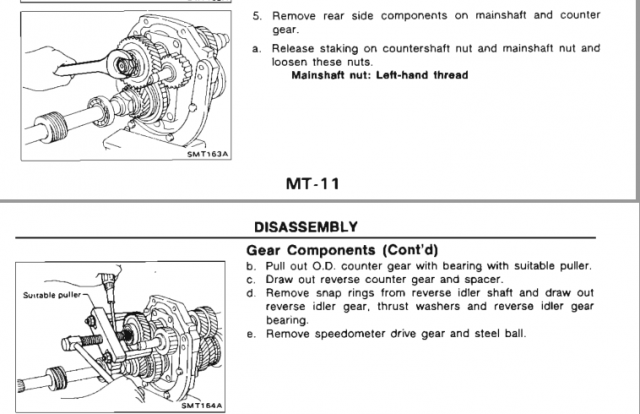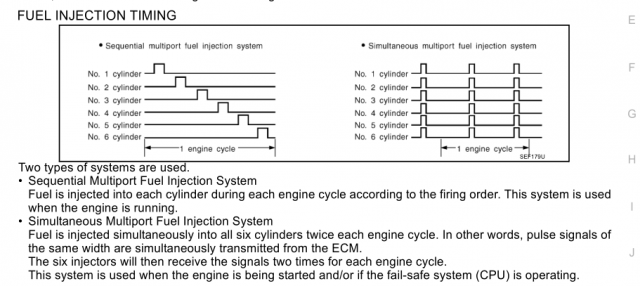
NewZed
Members-
Posts
6700 -
Joined
-
Last visited
-
Days Won
72
Content Type
Profiles
Forums
Blogs
Events
Gallery
Downloads
Store
Everything posted by NewZed
-
You could find an O-ring that will fit the pintle cover of a barbed injector and make it work. You can run 14mm injectors on a stock intake, using the barbed injector gaskets on the 14mm injector, or two O-rings. They seal the way Nissan sealed them back then, compressed gasket, instead of using an O-ring type seal. Do some study on how seals seal and an idea will come. There are design specs out there for O-ring sealing. And you don't need the special tool to cut a new hole for a bigger injector. You just need to put more care in to cutting the hole using standard tools. The special tool makes things fast and easy and accurate but it's not necessary. Just saying...
-
You can see the clip to let the idler gear free. Find out how to get the fifth gear removed to let it come off the shaft. Might be shown in the manual, MT chapter. Looks like you can pull 5th and change the idler then put it all back together. Get a new nut before you start, you'll probably destroy the old one when removing it. http://www.nicoclub.com/archives/nissan-240sx-factory-service-manuals.html Try a more descriptive title of your thread also if you want to get some views. "Reverse idler gear" doesn't really draw the eye.
-
You're in a bit of a bind here. If you tell how much you were asking you'll look like you're trying to sell your car without being a donating member. From what I've seen, the ZX crowd hangs out at zcar.com. Hybridz members buy ZX Turbo cars so that they can take the motor and dump the body. No offense, that's just the way it is. Go to zcar if you want ZX opinions, I'd say. As far as modifying the engine to get more money for the car, when I see somebody else's garage-done engine work I feel like they probably screwed something up. It lowers the value, doesn't raise it, unless they are a professional engine builder or have obvious or well-known skills. But that's just me.
-
LS1 240 mounts (facts not opinion???)
NewZed replied to trackzpeed's topic in Gen III & IV Chevy V8Z Tech Board
You have your causes and effects mixed up. The wrong pinion angle can cause propeller shaft vibration, not diff noise. Diff noise is mostly inherent to the R200 design, and isolated from the cabin by mounting it properly. -
Don't overlook gear ratios. You might need a new diff also if your ratios change much. The 80-83 280ZX transmissions are fine for normal sporty driving. And if you're looking because you have some grinding or noise, there are cheaper fixes than total replacement.
-
These two guys give a pretty good summary of the pros and cons of the 240SX/71C swap http://www.motortopia.com/cars/1973-datsun-240z-11118/car-pictures/240sx-transmission-swap-14041/DSC04293JPG_Thumbnail1.jpg-266482 http://zhome.com/ZCMnL/tech/240SX5spd/transmission.htm The Z32 swap requires an adapter. What do you mean by "upgrade"? How could a different transmission be better? You need to define that to make a good decision.
-
The contacts get pitted and holed after a few billion clicks so can still get hot if they're not refurbished well. There was somebody that flipped the contact lever around and used the other clean, unpitted end. Apparently there's an extra set unused in there, Can't remember the details. The other part of the problem is that the running lights switch has the same issue. So total heat buildup is pretty high. With a simple relay, current through the headlights portion is reduced to almost nothing. So you can take the switch apart or cut a few wires.
-
Crazy idea? Seeking opinions on this intake
NewZed replied to tyler031734's topic in Nissan L6 Forum
Tyler0 hasn't confirmed what he's working with. You're right though, I missed hsi comment about "much longer" so I was off there. But I went out and gained some internet expertise and see that runner length has more to do with moving the power peak's RPM number, not so much the total output. Runner diameter affects total power more. And he says he has more runner area, so he should get more total power. Even if the power peak moves down. Win-win maybe. My main point is that nobody can really say that any design rule, let alone every rule, has been violated until tyler0 defines what he's trying to do. Maybe his goal is low end torque. Maybe it's for a turbo motor. Maybe he needs the larger area for more overall power. I was countering the waste of time negativity. CM hasn't built any intake manifolds and he's apparently assumed that he knows what tyler0's goals are. Looks interesting to me and some positive discussion could be educational. No need to kill the buzz with negative comments. -
Not uncommon for the headlights switch itself, on top of the column, to get hot. All of the headlights current flows through the switch. There are relay setups out there. You can go halfway on the relays, just the current through the switch but not the grounding circuit at the dimmer, and just save the switch. Check the wiring diagram to see. You didn't say what year your car is, I think there might be some changes over the years. I have a 76 280Z and put a relay in front of the switch after the solder joint let go a couple of times.
-
Crazy idea? Seeking opinions on this intake
NewZed replied to tyler031734's topic in Nissan L6 Forum
The basic question is whether it's better than the stock L6 intake, not if it's the best intake ever. And some of the people with the strongest opinions here don't have any verified expertise in manifold design, just years of stuff they read somewhere. Like me. If you measured the length of those runners you'd probably find that they're shorter than the stock gasoilne L6 runners. So that comment doesn't fly. As far as distance from the intake ports, it's closer than throttle body injection. You wouldn't know the benefits over the stock manifold without measuring though. Which is the problem with most aftermarket manifold designs. They look like they should be better but actual measurements are often non-existent. -
1972 240z with L28 5 Speed, Clutch issues
NewZed replied to OSU-zanatic's topic in S30 Series - 240z, 260z, 280z
You said it fully disengages. But grinding in to reverse says otherwise. Search "throwout collar" and various other clutch words. Use Google and "site:hybridz.org" and you'll get better results. If you didn't measure the stack height (another good search term) of the parts before installing you might need to start over.- 3 replies
-
- clutch
- transmission
-
(and 2 more)
Tagged with:
-
1972 240z with L28 5 Speed, Clutch issues
NewZed replied to OSU-zanatic's topic in S30 Series - 240z, 260z, 280z
Could be drag. Push brake pedal to know for sure.- 3 replies
-
- clutch
- transmission
-
(and 2 more)
Tagged with:
-
Here's the sketchy part, along with much of what the guy writes in his ebay ad - "The lift is .535 Don would never tell the duration of his cams. If your the lucky winner, I will let you know the duration." Pretty easy to replicate a machine part, duration would have been easy to determine. Power comes from the combination of parts, not just a cam profile. The guy's selling snake oil and magic.
-
The clips are hard to get locked on. Press harder. I was being ironic about the picture. It's hhuuuugggee.
-
It's a 73 distributor. The cap only fits one way, with a square locating piece by one of the clip areas. Maybe you had it backward. "Slightly too big" doesn't tell much about how it doesn't fit. Can you make that picture any bigger?
-
77 280z won't stay running, no idle, out of ideas
NewZed replied to akanning's topic in Trouble Shooting / General Engine
Good luck. And you believe wrongly. 78 got the N47 on N42, Mid-80 or 81 got the P79 on F54. P90 came in 81, on the turbo. If you really want to go directly to what the ECU sees, check the coolant temperature circuit at the ECU plug. That way you won't have to determine if it's a CHTS or a thermostat housing based sensor. All that matters anyway, is what the ECU sees. -
77 280z won't stay running, no idle, out of ideas
NewZed replied to akanning's topic in Trouble Shooting / General Engine
Check the coolant temperature sensor. Sounds like it's running super-rich, with the blackish-smoke. That engine is a 280ZX engine, maybe a turbo engine, so whoever put it in might have used the CHTS instead of the coolant temperature sensor. Either way, they need to be connected and indicating engine temperature, otherwise the ECU sees an arctic-cold engine and dumps lots of extra fuel. -
Where'd you get the frame rails? And why'd you weld the engine mount on before verifying proper fitment? You seem to be combining two things in to one. An engine mount for some as-yet unidentified engine, and frame rail replacement. Not really connected to each other. You wrote like the engine mount is part of the rail replacement, but it's not. Seems like you might be on the start of a trail of errors.
-
Oops. That's the Mega documentation for you. These discussions all need good definitions of terms as they proceed otherwise people think that they're talking about the same things when they're not. There was a conversation about sequential ignition a while back that made little sense to me, since a spark out of sequence really isn't worth much. But the word was used to distinguish from wasted-spark. Which is still sequential where it matters.
-
Links without words attached aren't really worth much. No offense. Here's one that offers about as much, maybe more actually than the MSextra link - https://www.google.com/webhp?tab=ww&ei=dq5PVNe5B8j8igLU9ICABg&ved=0CAMQ1S4#q=sequential About the same as posting the word "search". Edit - point being, what's in that msextra link that is relevant?
-
Here's how the factory defines it. Literally, the word only means that injection happens in order, or sequence, of cylinder actions. Doesn't say anything at all about when injection happens, within a complete cycle. But each cylinder sees the same type of charge; well-blended, inhomogeneous, straight in to the open intake port, or whatever. Unlike batch where the cylinders see a different type of charge since there are six possibilities, each cylinder seeing two of the possibilities.
-
This thread covers a lot - http://forums.hybridz.org/topic/50208-the-ultimate-l28et-guidewhat-you-need-for-350whp/ Worrying about whether the distributor in your seized engine is still good and the clean look of COP shows a little bit of unfocus. For the money you're spending on other parts you could consider one of the damper mounted sensors. Probably more dependable, maybe cheaper in the long run. And a clean look. Looks like you're still early in planning. DIYA has tried to make sense of the mess of options and MS variations. Even they get sucked in to a vortex of possibilities but still worth reading their articles - https://www.diyautotune.com/support/tech/
-
As I understand things, sequential was devised almost solely for emissions purposes. Probably gives a smoother idle too.
-
Nice. Hope it keeps working for you. You were doing all the right things.
-
The Nissan u-joints are very high quality, precise and accurate machine parts. A 100,000 mile Nissan u-joint with the proper thickness retaining clips is probably tighter than a brand new parts store u-joint. Don't assume that new is better. Those Nissan joints are good stuff.

